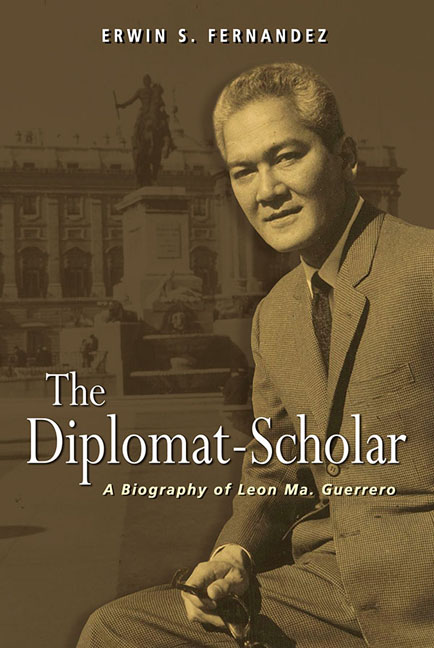Book contents
- Frontmatter
- Dedication
- Contents
- Preface
- Prologue
- Chronology
- I Ermita and Santa Cruz to Intramuros: Between Literary and Legal Career
- II To Tokyo and Back: The Making of a Diplomat
- III Going In, then Out of the Political Jungle: Padre Burgos to Arlegui
- IV London and Madrid: The Philippines in a Resurgent Asia
- V New Delhi to Belgrade: The Philippines towards Non-Alignment
- Epilogue
- Glossary
- List of Abbreviations
- Bibliography
- Index
- About the Author
- Frontmatter
- Dedication
- Contents
- Preface
- Prologue
- Chronology
- I Ermita and Santa Cruz to Intramuros: Between Literary and Legal Career
- II To Tokyo and Back: The Making of a Diplomat
- III Going In, then Out of the Political Jungle: Padre Burgos to Arlegui
- IV London and Madrid: The Philippines in a Resurgent Asia
- V New Delhi to Belgrade: The Philippines towards Non-Alignment
- Epilogue
- Glossary
- List of Abbreviations
- Bibliography
- Index
- About the Author
Summary
Leon Ma. Guerrero “was one of the best writers in English the country has ever produced”.
F. Theo Rogers, Guerrero's superior in the Philippines Free Press“A distinguished Filipino diplomat, the most eminent and the best equipped in our Foreign Service.”
Claro M. Recto, Speech before the Chamber of Commerce of the Philippines, 1956“Ambassador Leon Ma. Guerrero has distinguished himself in the profession of letters… To Philippine letters he has brought a profound sense of history… His nationalism is the more profound because he has not repudiated the past but rather learned from it.”
Carlos P. Romulo, Address before the Philippine Academy of Sciences and Humanities, 1965Upon his retirement, Leon Ma. Guerrero was the most senior career ambassador in the Philippine Foreign Service. Although he did not want to retire, heavy smoking and hard drinking had taken a toll on his health. His emphysema worsened. Yet, his interest in international affairs did not diminish. Seated or in bed while smoking, he would read Philippine newspapers and Time magazine bought to him by his houseboy whom he had difficulty conversing with in Tagalog. He could not walk because of a broken hip so that he had to use a wheelchair.
During the last two years of his life, he suffered from bouts of depression leading him to alcoholism. He would drink tea during breakfast but would skip his meal to drink brandy in the morning. Difficult to feed, he would only eat sotanghon with soup, a diet that made him bony and lean. Once, Chitang brought him food for he was said to be pining for Ermita food. “I brought him,” she reminisced, “dishes from a caterer, French galantine, puffy ukoy made from rice flour that Mamá used to cook for him, empanaditas wrapped in mille feuilles, pasta de mil hojas, but he would throw them at the wall, fretfully complaining that they were not at all what he remembered.” “I lost my patience one day,” she continued, “and replied sharply (only to regret it as soon as I'd said it) that he was not at all what I remembered either [her emphasis].”
- Type
- Chapter
- Information
- The Diplomat-ScholarA Biography of Leon Ma. Guerrero, pp. 295 - 312Publisher: ISEAS–Yusof Ishak InstitutePrint publication year: 2017

